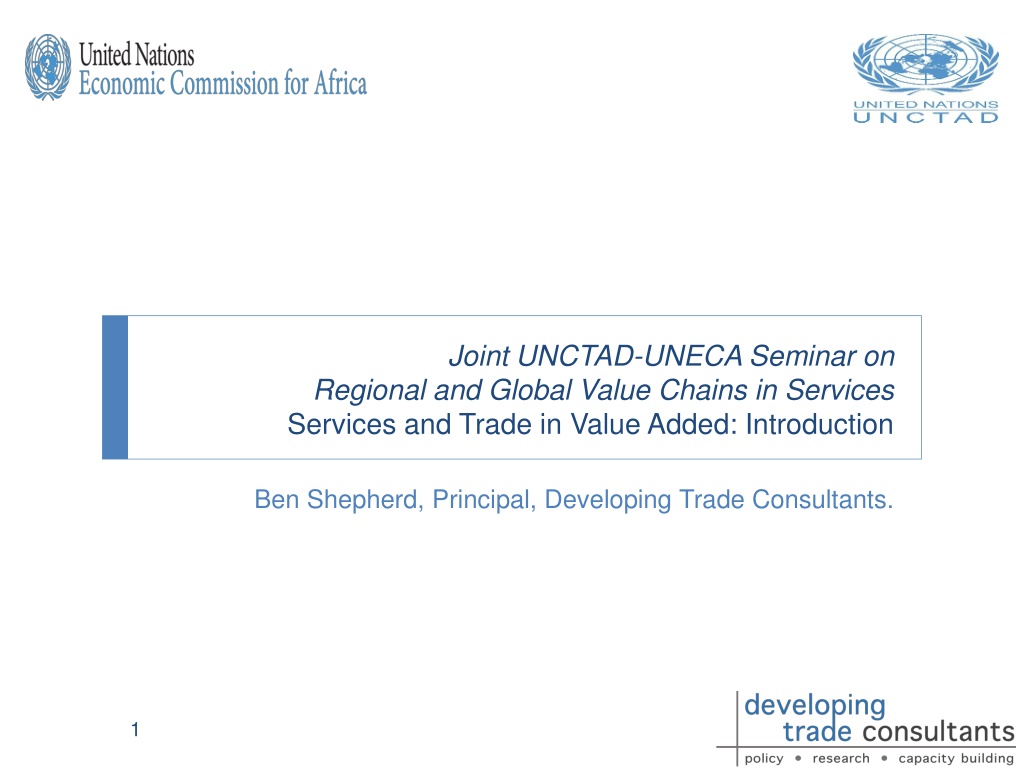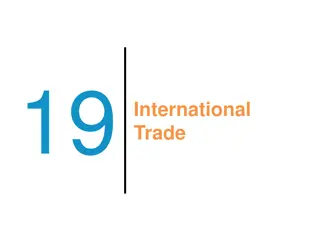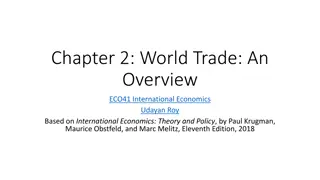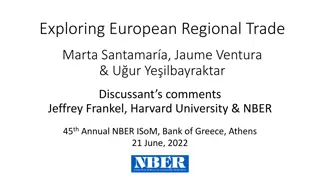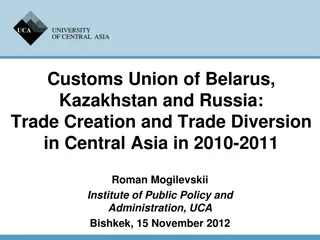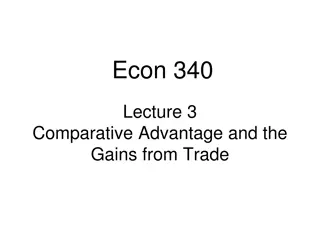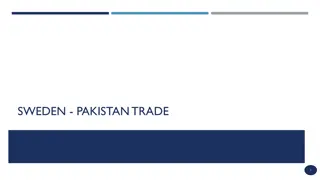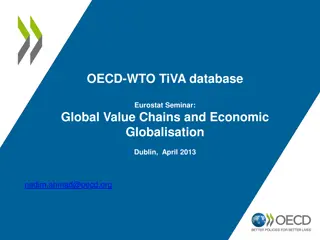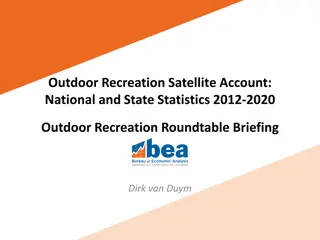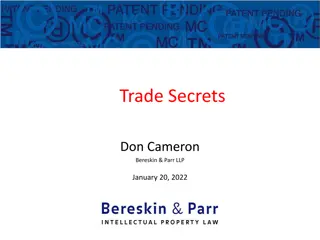Understanding Trade in Value Added: Key Insights from Joint UNCTAD-UNECA Seminar
Explore the complex world of Regional and Global Value Chains (RVCs/GVCs) in services and trade, presented at a seminar by Ben Shepherd, focusing on the importance of measuring trade in value added for a more accurate economic picture. Discover key takeaways, data requirements, and the rationale behind this crucial aspect of global trade analysis.
Download Presentation

Please find below an Image/Link to download the presentation.
The content on the website is provided AS IS for your information and personal use only. It may not be sold, licensed, or shared on other websites without obtaining consent from the author. Download presentation by click this link. If you encounter any issues during the download, it is possible that the publisher has removed the file from their server.
E N D
Presentation Transcript
Joint UNCTAD-UNECA Seminar on Regional and Global Value Chains in Services Services and Trade in Value Added: Introduction Ben Shepherd, Principal, Developing Trade Consultants. 1
Key Takeaways Trade in RVCs/GVCs is characterized by the geographical unbundling of production activities (second) in addition to the geographical unbundling of production and consumption (first). Results in intensive trade in intermediates. 1. RVCs/GVCs offer a new development model: joining and moving up (Viet Nam) rather than constructing a whole supply chain from scratch (South Korea). 2. With the rise of trade through RVCs/GVCs, gross value trade data provide a less and less complete picture of the economic nature of the transactions that create trade. 3. This has created a rationale for trade in value added, which tracks the origin of value added in exports by origin country and sector. 4. Key data sources are supply use tables (based on representative surveys of businesses), which are converted to IO tables, plus trade data. MRIOs for developing countries use a large amount of imputed data, so be extremely careful using them. 5. The math (next session) is relatively straightforward. The magic of MRIOs is in the data work required to assemble them! Hence data quality and completeness determines their usefulness for policy. 6. 2
Outline Rationale for Measuring Trade in Value Added 1. Data Requirements for Trade in Value Added 2. 3
3. Rationale for Measuring Trade in Value Added Trade is measured on a gross shipments basis, i.e. invoice price (or potentially a reference price). GDP is measured on a value added basis, i.e. invoice price less the cost of intermediate inputs. Hence, trade statistics from Customs are not directly compatible with the national accounts (GDP). Value chains put a further twist on the problem 4
3. Rationale for Measuring Trade in Value Added Total = 100 Country A 50 Country C -100 Country B 50 5
3. Rationale for Measuring Trade in Value Added Total = 150 Country A 50+50 Country C -100 Country B 50 6
3. Rationale for Measuring Trade in Value Added In this example, B ships 50 units of intermediates to A, which adds 50 units of value itself, before shipping to C. Gross value trade statistics show: World trade of 150 units. Exports from B to A of 50 units. Exports from A to C of 100 units. Exports from B to C of 0 units. The deeper the RVC/GVC model proceeds, the more of a disconnect there is between GDP, world trade, and bilateral trade. Measuring trade in value added tries to untangle this picture by identifying: Value added of 50 units originating in B. Value added of 50 units originating in C. Total world trade in value added of 100 units. 7
3. Rationale for Measuring Trade in Value Added Gross Value of iPhone Imported into USA Value Added Breakdown of iPhone Imported into USA 250 250 200 200 150 USD 150 USD 100 100 50 50 0 United States Korea Unidentified Japan China Taiwan Europe 0 China 8 Source: https://bit.ly/2PwTrHO.
3. Rationale for Measuring Trade in Value Added Trade in value added allows us to decompose exports in gross shipments terms into value added components by source. Source is typically a sector-country pair. Includes the importing country as a source! Identify value added components within services sectors (standalone RVCs/GVCs) and also value added of services as a component within other sectors (embodied services in RVCs/GVCs). Has a profound effect on bilateral trade balances for country pairs with substantial trade in intermediate goods and services. 9
3. Rationale for Measuring Trade in Value Added Trade balance in gross shipments terms = exports imports. USA-China Bilateral Trade Balance 0 Gross Value Added Trade balance in value added terms = US origin VA in US final demand Chinese origin VA in US final demand. -50000 -100000 Taking proper account of trade in intermediates and embodied VA reduces the size of the bilateral deficit by 35% Million USD -150000 -200000 NB: No suggestion that bilateral balances matter for other than political reasons! -250000 -300000 10 Source: OECD-WTO TiVA.
4. Data Requirements for Measuring Trade in Value Added The breakdown of value added in the iPhone example is intuitive. We could, in theory, go to Apple and track the origin of all the components in the iPhone, and the components of the components, and so on Until we have a full breakdown. Intuitive for one product, but how do we do it for aggregate sectors, or even the economy as a whole? In other words, how do we systematize this breakdown approach? Basic math provides a helping hand A good starting point for thinking about how to solve the problem is to consider the types of data that might be helpful. 11
4. Data Requirements for Measuring Trade in Value Added Bilateral trade data by sector: record of gross shipments moving across borders. Goods Services 1. Input-Output table: measure of how each sector uses the output of each other sector. Needs to combine: Goods Services All countries of interest. 2. 12
4. Data Requirements for Measuring Trade in Value Added Data on bilateral trade in goods are readily available. WB WITS server provides a convenient interface for accessing UN Comtrade. Internationally harmonized data available at the HS 6-digit level (more detailed data available from national Customs). Typically need to aggregate data using a concordance to another classification, such as ISIC. Accounting for re-exports in small open economies is a problem. Non-agreement of bilateral data is a problem: A s reports of exports to B does not typically equal B s reports of imports from A. Technical solutions exist to balance the trade matrix, as in the BACI database. More of an issue in countries where governance is weak, and/or there are problems of mis-classification and mis-invoicing at the border. No systematic data available on informal trade, which is substantial in many parts of Africa. Innovative estimates exist (e.g., in UEMOA, CILSS), but sources are still being refined. 13
4. Data Requirements for Measuring Trade in Value Added Data on bilateral trade in services are much less readily available. No African country reports bilateral trade in services data to UN Comtrade: only trade with the rest of the world as an aggregate. Most countries only report a limited number of sectors (EBOPS) to UN Comtrade. Mirroring can fill in the blanks in South-North trade, but no simple method for South-South trade. OECD-WTO BATIS: experimental dataset that uses mirroring and statistical techniques to fill in and balance the bilateral trade in services matrix. Best available data. Still need a concordance to map services trade data to ISIC sectors. Many countries in all regions have incomplete trade in services data: strong need for capacity building with NSAs in this area. 14
4. Data Requirements for Measuring Trade in Value Added Intuitively, an input output table relates: Final demand Gross output Value added Input use In developed countries, IO tables are typically prepared as part of the national accounts exercise, but preparation is expensive and requires considerable expertise. Most countries prepare them less than annually and with a substantial lag. We will look at the mathematical representation of an IO table in detail in the next section; here, focus on intuition and use. 15
4. Data Requirements for Measuring Trade in Value Added A national IO table tells us, for each sector, how much of its output: Is used by other sectors as an intermediate input. Enters into final consumption. At the same time, it also tells us, for each sector, how much of the total value of its output: Is made up of intermediate inputs from other sectors. Is value added. Some countries also apportion outputs across export destinations, and inputs across import sources. If not, we apply the proportionality assumption to trade data: products are used by importing sectors in the same proportions in which they are imported. 16
4. Data Requirements for Measuring Trade in Value Added The fundamental ingredient of an IO table for analytical purposes is a Supply Use Table. Building block is a statistically rigorous survey of businesses. Use a sampling frame (business register, tax IDs, etc.) to identify a representative sample. In practice, surveys are burdensome, so tend to focus on larger firms that account for the bulk of production and intermediate consumption, then use statistical methods to complete. Together, the supply table and the use table show how outputs are used, and how inputs are sourced. To move to an IO table, statisticians perform a number of operations including: Balancing supply and use. Taking account of trade margins and taxes. Moving from producer prices to basic prices. Applying technology assumptions and sales structure assumptions. NSAs are the experts in actually doing this. Key for present purposes is to have a sense of where the data come from. 17
4. Data Requirements for Measuring Trade in Value Added Extending an IO table to a multinational framework (MRIO) is an extremely complicated undertaking: Harmonization of IO tables by sector. Harmonization of trade data with harmonized IO tables. Balancing bilateral and sectoral flows. Data lag is a major issue, so TiVA data can only typically be prepared with some years delay, unless extrapolation techniques are used. All of these issues are serious for the largest developed countries. So they are all the more so for developing countries, particularly small countries and low income countries / LDCs. The math behind estimating trade in value added is actually much easier than the data work involved in putting a MRIO together! 18
4. Data Requirements for Measuring Trade in Value Added There are essentially three commonly used data sources on trade in value added: OECD-WTO TiVA: 63 countries and 34 sectors, but only South Africa among African countries. Major intergovernmental effort. Data to 2011, plus a nowcast to 2014. Raw data + user friendly website. WIOD: 43 countries and 56 sectors, no African countries. Private initiative based primarily on EU data. Data to 2014. Raw data only. Eora: 190 countries, 26 sectors (harmonized version). Good coverage in Africa. Data to 2015. Raw data + indicators prepared by UNCTAD. For quantitative work on trade in value added in Africa, Eora is the only source available. Some work is required to make the data talk . UNCTAD s indicators are extremely useful, and make possible the sort of analysis undertaken here but a strong understanding of how to get there is necessary to correctly interpret the information. However, there are some important caveats: Essentially all of the trade in services data is estimated or imputed. IO tables are computed infrequently, so there is again a strong role for imputation. Eora has been little used in published research, unlike the other two datasets, and so has not fully passed peer review. One view is that aggregate results are likely fairly reliable, but that sectoral data are less so. By all means work with these data, but important to acknowledge the huge uncertainty that exists around estimates. 19
Additional Resources Data: OECD-WTO TiVA dataset: https://stats.oecd.org/index.aspx?queryid=75537. Eora raw data: http://worldmrio.org. UNCTAD Eora GVC indicators: http://worldmrio.com/unctadgvc/. Reading: Sebastien Miroudot and Koen De Backer (2013) Mapping Global Value Chains (OECD): https://bit.ly/2BcvOeS. Ben Shepherd (2017) Global Value Chains and Development of Light Manufacturing in Ethiopia (EDRI): https://bit.ly/2QM32ao. Richard Baldwin (2013) Trade and Industrialization after Globalization s Second Unbundling (NBER): https://www.nber.org/chapters/c12590. Sebastien Miroudot (2017) Services in Global Value Chains (OECD): https://bit.ly/2DHkQjY. 20
